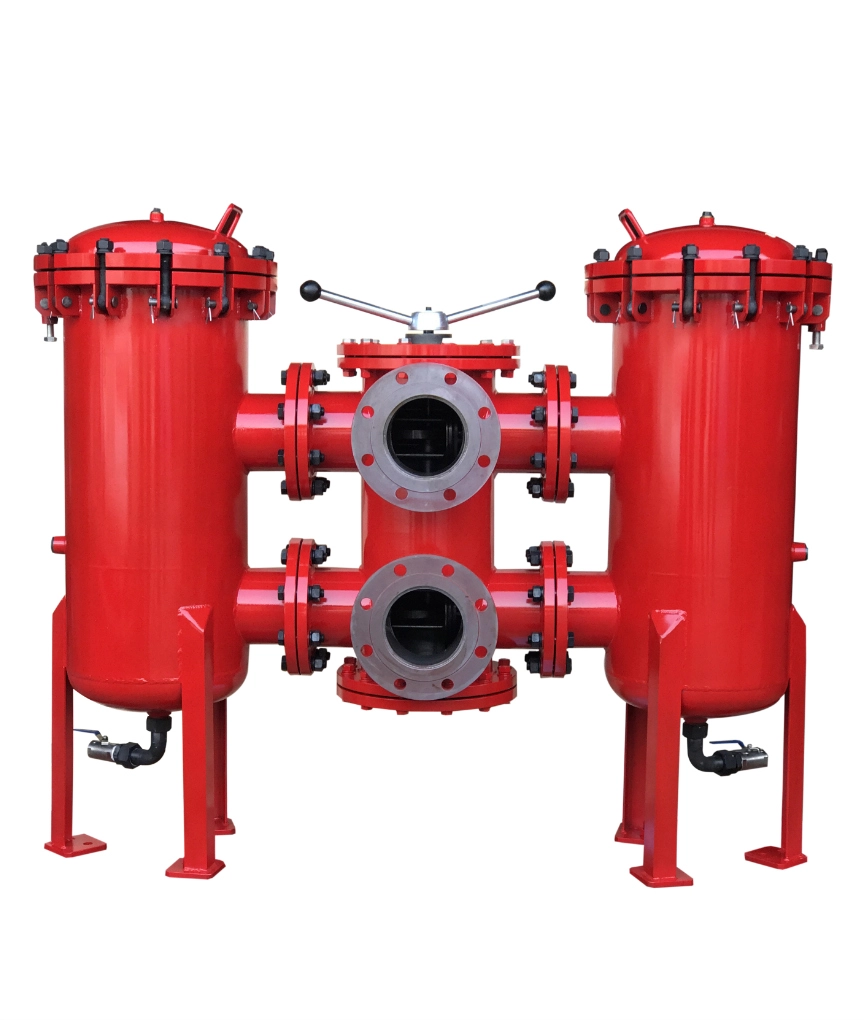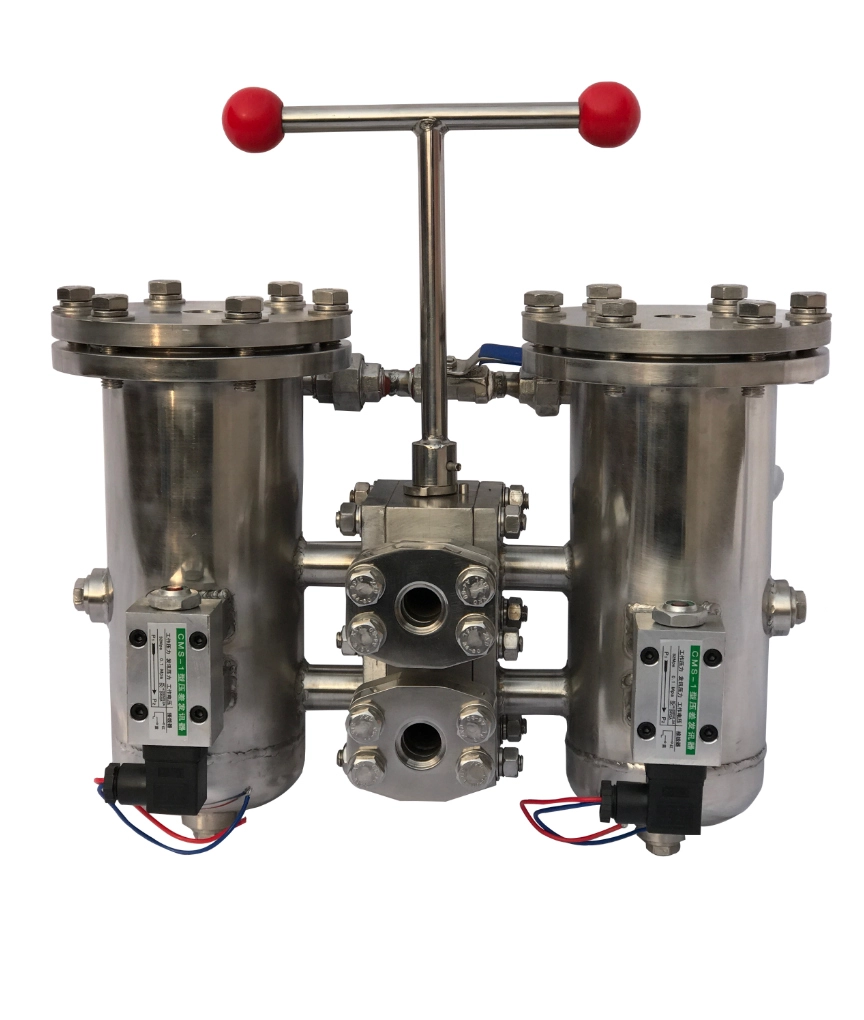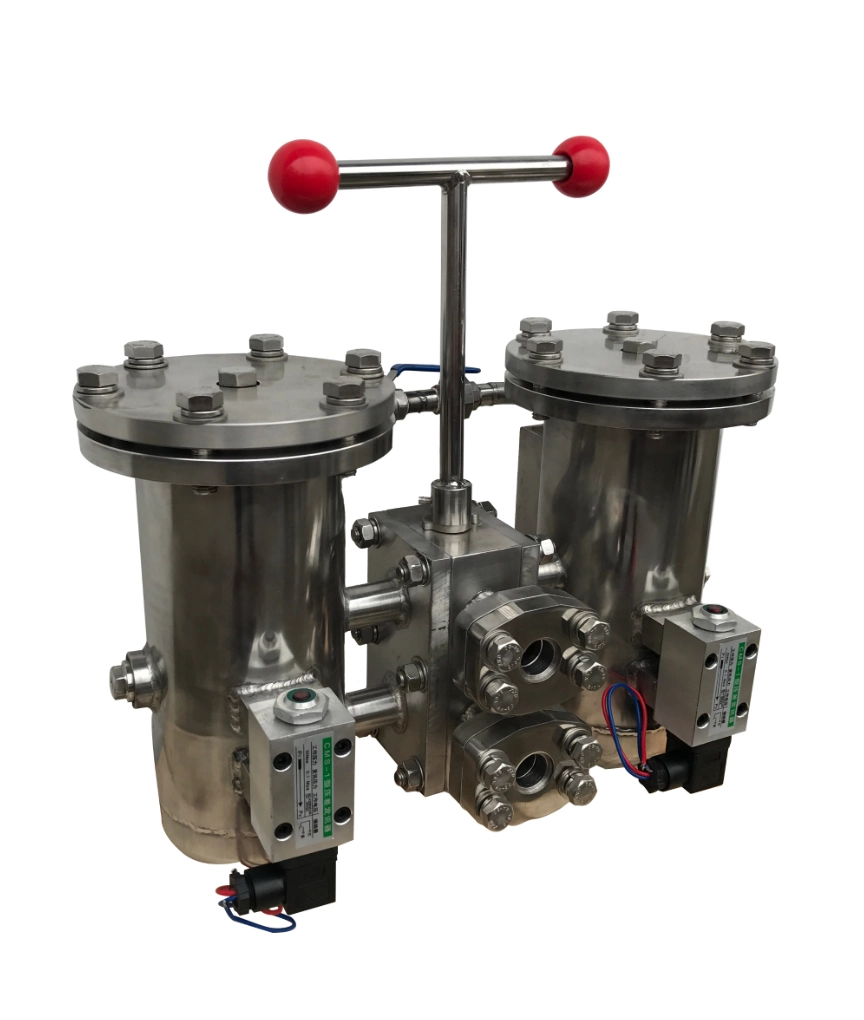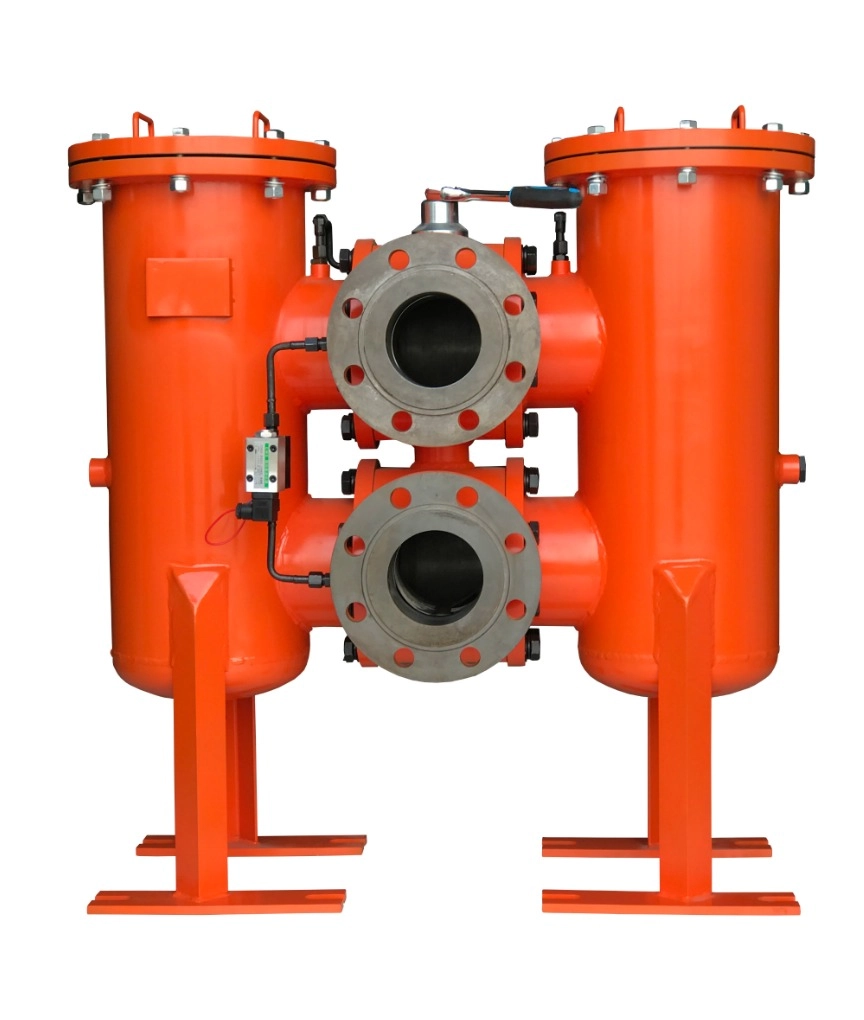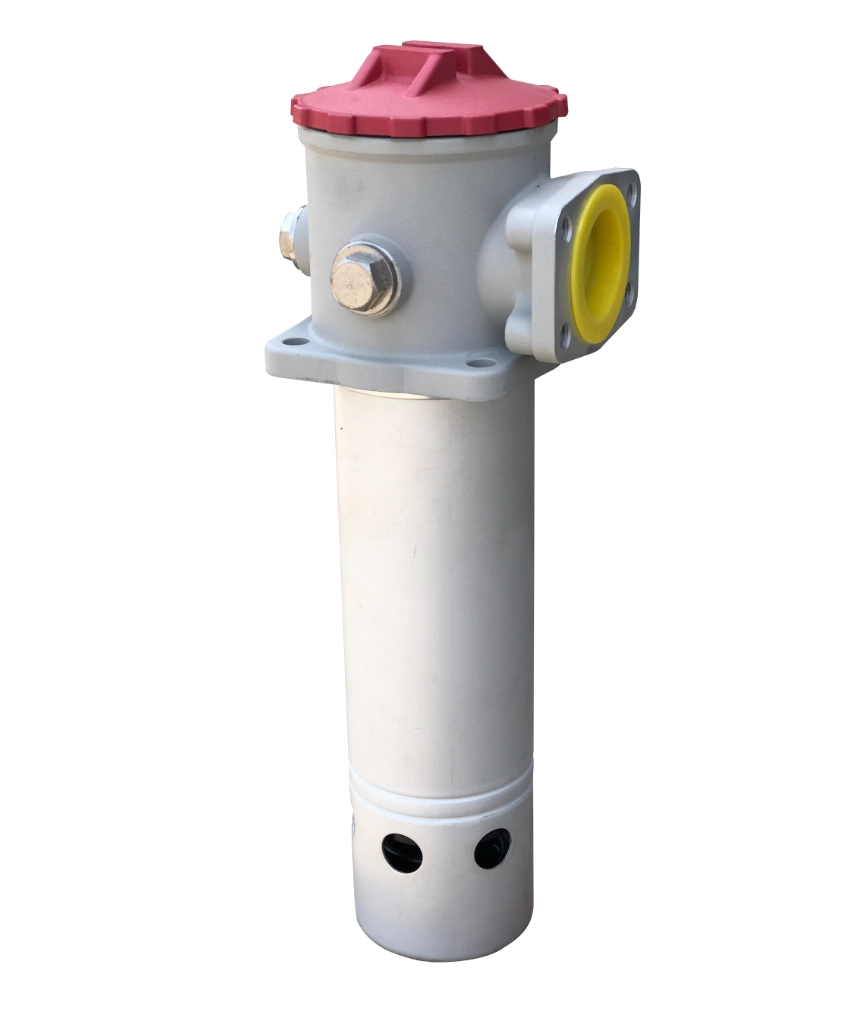FilSon stainless steel duplex filter housing delivers high filtration performance and easy operation in the continuously operating system.
There is a three-way-changeover ball valve between the two stainless steel filter housings, making our duplex filter housing possible to switch from the dirty filter side to the clean side without interrupting operation. All duplex filter housings made from SS 316 & SS304 are mirror polished to resist adhesion of dirt and rust.
- Maximum flow rate to 7800 l/min
- Filter housing: 304/316 stainless steel
- Connection for a clogging indicator
- Ball change-over valve for good sealing
- High dirt holding capacity and easy maintenance
- Details
- Technical Data
- Overall Size
- Importing Guide
304/316 Stainless steel duplex filter housings are simple in construction and easy to use. Duplex type strainers with stud-and-nut are supplied with balancing valves to equalize pressure and ease turning of the valve.
Clogging indicators are available for protecting the hydraulic system safety and reliable seals. These series of duplex filter housing can handle flow rates up to 7800 liters per minute, with a working pressure up to 2.5Mpa.
Duplex filter housing is the most important part in a duplex filter, Filson has over 20 years manufacturing experience with duplex filter housing, so if you need a duplex filter bag housing, Filson will be your premier choice.
Flow Rate: 25 – 7800 L/min
Temperature: -30°-121°C(-22° to 250°F)
Connection: DN20 – DN250
Working Pressure: ≤2.5 Mpa
Pressure Loss: ≤0.35 Mpa
Filtration: 3, 5, 10, 20, 40,100 μm
By-pass setting:4 Mpa
Supply Power: 24V/48W, 220V/50W
Element Number: 1*2~6*2
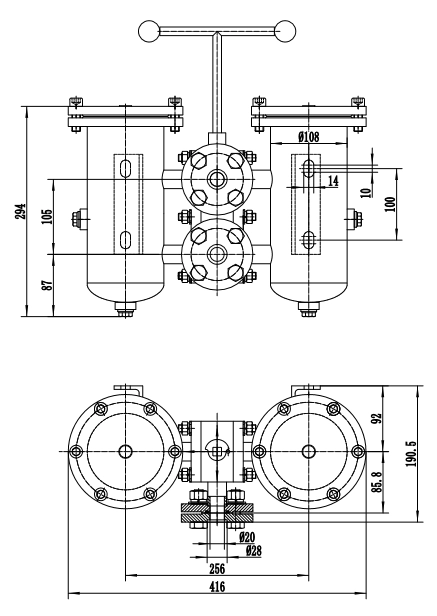
Duplex Filter Housing: The Complete Guide
In this short guide, I am going to walk you through various aspects of a duplex filter housing.
I am going to explain what it is, how it works, technical specification, assembly process and cleaning procedure, just to mention a few.
You know what?
By the end of this guide, you’ll be a real expert in duplex filter housing.
Let’s get to it:
What is a Duplex Filter Housing?
Duplex filter housing is a duo sturdy enclosure that carries the filter media elements (filtering unit), pressure gauge, blow-down valve.
In addition, it has an inlet and outlet openings for the hydraulic fluid system. The two filter housings are joined together through change-over ball.
The whole design does not only take up a little space, but also avoids leakage possibilities at the end connections, even when replacing the filter element.
This feature makes a duplex filter special as it can allow continuous operation with no downtime for cleaning.
The duplex filters are connected at the common diverter so that when one filter is dirt-lodged the medium flow is diverted to the other filter housing via the ball valve.
This offers enough time for repair and maintenance on the other filter housing. The filter cartridge housing can then be opened, washed, changed or overhauled.
Duplex filter housing is suitable for filtering hydraulic fluids, liquids and lubricating oils. What follows is an image of duplex filter housing:
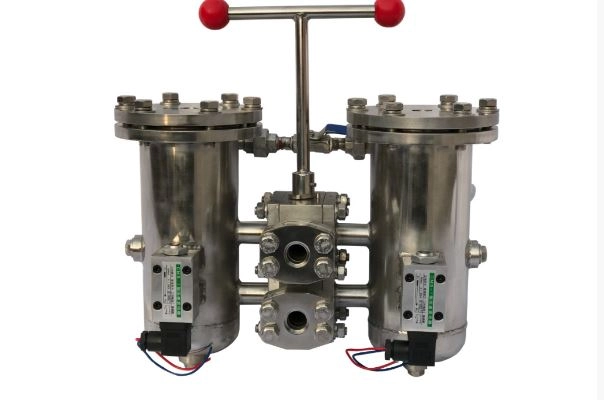
Stainless steel duplex filter
It is a most reliable device for maintaining uninterrupted operation of continuous medium circulation in a oil circuit.
To put it in perspective:
The duplex filter housing is ideal for systems that cannot allow medium flow interruptions.
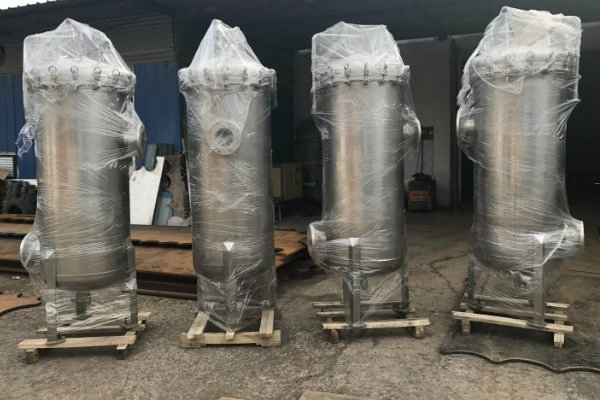
Continuous medium flow is maintained via the usage of the duo basket chambers while the plug redirects the flow from one basket to the other.
The duplex filter housing is instrumental in ensuring a robust, steady and optimal filtration process in the filtration circuit.
Hence, duplex filter housing is used for basket strainer, inline filter, bag filter, cartridge filter, dust collection filter and what have you.
For easy termination of duplex filter housing, the end connections are properly flanged or threaded.
Duplex filter housing is designed for various application environments like low and high pressure, extreme temperature applications.
Duplex filter Housing Material
If there is a critically essential innovation on piping circuit devices is a fabrication of duplex filter housing.
Most fabricated designs of duplex filter housing use tall strainer structures that can accommodate longer basket filters.
This special configuration feature helps increase medium holding capacity and receive longer interval runs during the changeover procedure.
Duplex filter housings can be customized on request and the system incorporates industrial and manifold valves.
Such types of duplex filter housings generally come with an offset inlet/outlet design.
Let’s find out what material duplex filter housing is made up of:
a) Stainless Steel 316 (SS 316)
Duplex filter housing with type SS 316 is made up of genuine chromium-nickel heat-resisting and stainless steel.
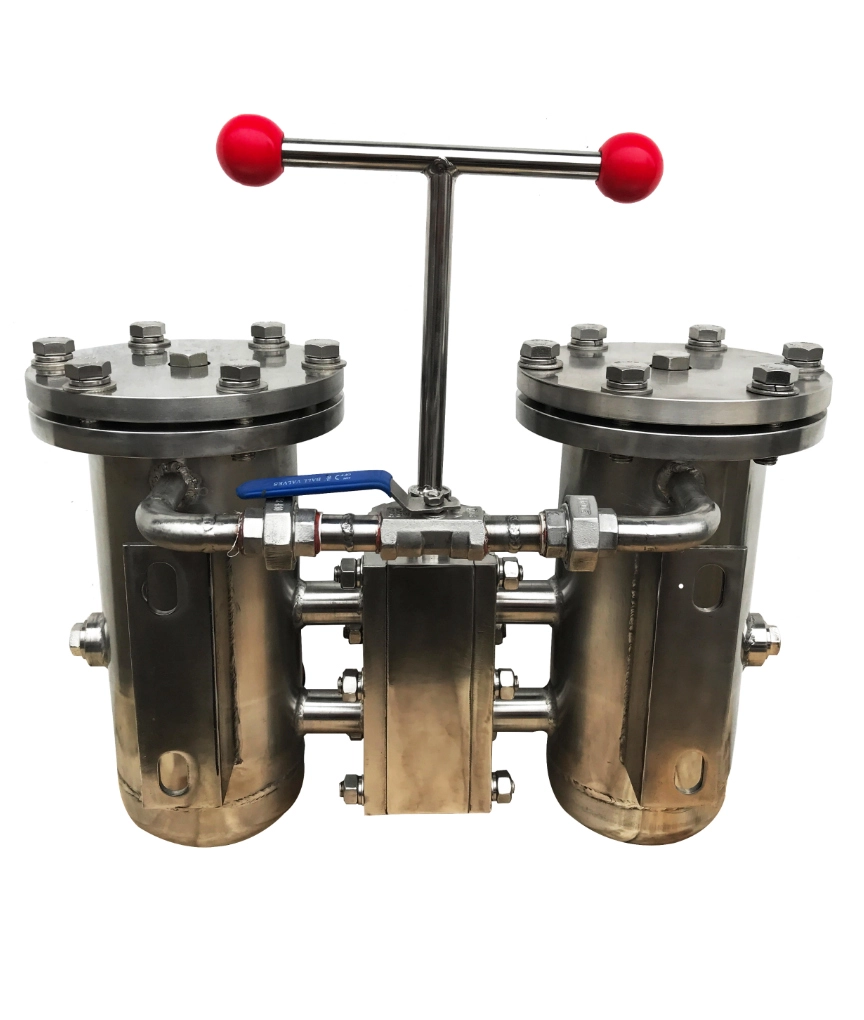
SS 316 Duplex filter housing
For a fact, it has a much superior resistance to corrosion when compared to other steel alloys under extreme severe application environment like brine solutions, sea water etc.
Type 316 stainless steel housing has molybdenum attributes to its greater resistance to chemical corrosion. For instance, fatty acids at higher temperatures, sulfuric acids.
In addition, SS 316 duplex filter housing is easy to make, finish and weld. The fact that SS 316 duplex filter housing is durable, it also costs slightly higher.
It is important to consider buying SS 316 duplex filter enclosure when designing an outdoor system or for drinking water level, food-grade standard level.
b) Stainless Steel 304
Type 304 stainless steel also has an alloy of chromium-nickel, however, with low-carbon content. It is the commonest type of duplex filter housing material on the market with authentic stainless steels.
Its alloy is drawn from modification of 8% nickel and 18% chromium authentic alloy that is durable and resistant to corrosion and oxidation.
This duplex filter housing material delivers best filtration performance specification as well as provide ease of access and operation at the site.
SS 304 duplex filter housing is highly affordable as compared to SS 316 material and has an array of applications.
This is suitable for building facades, heat exchangers, hose clamps and other fresh water application environments.
c) Special: Duplex Stainless Steel for Seawater
Sea water duplex stainless steel duplex filter housing usage is widespread in seawater applications, especially for desalination plants, floating production, oil and gas hydraulic systems.
FilSon duplex filter housing such as super duplex UNS S32760 material
provides the best exceptional material composition and properties for such applications.

duplex filter housing in sea water applications
This special stainless steel alloy is made with reduced chromium content of 10.5%, which forms an oxide film on the duplex filter housing surface to prevent corrosion. Avoiding diffusion of oxygen with steel helps achieve the instance.
The special stainless steel grades are imparted with huge amounts of molybdenum at 6% together with nickel Ni.
Also, it has some Nitrogen N that characterizes them with outstanding resistance to crevice corrosion and chloride pitting.
What’s more?
The use of duplex filter housing doped from super double phases stainless steel is suitable for sea water filtration systems because of the corrosion resistant properties of steels attained from alloy composition.
This has made special duplex cost-effective and reliable in seawater operations.
Note: Super dual-phase stainless steel filter housing must be equipped with the same material of filter elements to keep material consistency.
Technical Specification of Duplex Filter Housing
Why is duplex filter housing specification important?
This is because the filtering process takes place in the chambers.
Duplex filter housing is designed with a duo filter chamber; since one chamber is in operation the other remains as a standby.
The unused chamber is functional, however, becomes very essential at time of routine repair, servicing and maintenance.
So, what should you do?
The right technical specification for duplex filter housing comes with a diversion mechanism that adjoins the twin chambers. The diversion mechanism system plays the core role in the working of the duplex filter.
At the filtering unit, their seats a manifolds of filter media elements with a robust structural integrity. The design specification is compact and firmly holds the string of filter media material intact.
However, dimensions and materials are determined by the application environment.
Since the medium reaches the chambers at high pressure, the filtration system comfortably accommodates the rapid and rigorous filtering of solid particles out of the flowing fluid.
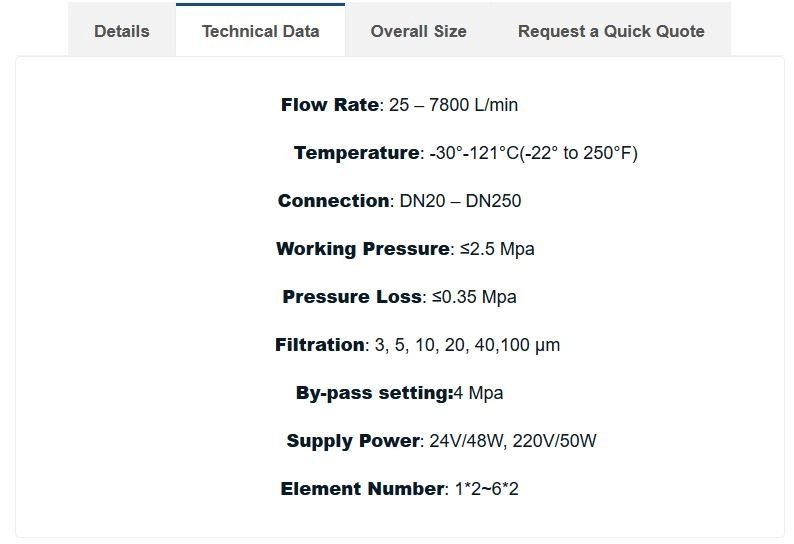
Technical specification of duplex filter housing
The filtration mechanism section goes through an effective design and construction so that to prevent leakages of fluid in between the filter media. This also helps to withstand pressure differential across each filter chamber.
A number of factors have to be put into consideration with filter element specifications:
- Diameter of the filter disc stacks
- Filter media ratings
- Number of filters in the stacks
Such factors are used to find the overall capacity of the filtering unit.
However, a duplex filter capacity can still be modified by adjusting the filtering units into a special arrangement. For example, arrange in parallel two or three filter units.
Now, it is clear what the duplex filter housing holds – the filtering unit and an external pressure gauge to check the build-up of pressure differential.
Duplex filter housing must exceed ISO multitest in terms of structural integrity, filtering unit capacity and ratings, as well as pressure and temperature operation specification.
Below are the ISO tests:
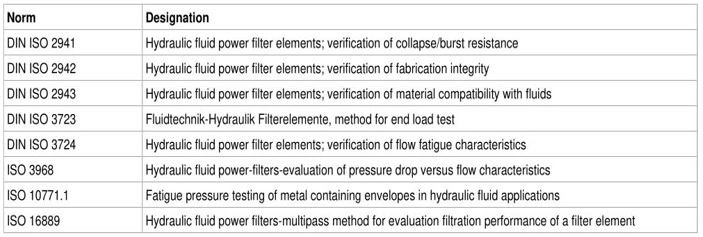
ISO Tests
Duplex Filter Working Principle/ Changeover Procedure
Duplex filter forms the filtering unit that seats inside the duplex filter housing. The inlet and outlets are connected on the other basket housing, thus the name duplex filter.
The full medium flow goes through the filtering unit element, where fluid contaminates are trapped and removed from the hydraulic system to avoid the known dangers.
In an instance where the filter element gets clogged, the medium flow circulation is diverted to pave way for repair and service.
The ball valve system plays the diversion by allowing proper medium flow shutdown to the clogged chamber which is bubble tight during the fluid flow redirection.
This procedure prevents costly leakage and danger that the running medium may have on the operator. Hence, offers a secure environment for operations.
Clogging of the fluid path can be determined by monitoring the pressure differential drop across the filter basket housing.
If there is a huge pressure drop across the filter element during operations, it is an alert signal to schedule for the filter element change-over procedure.
The duplex filter element is made of a robust disc-type to withstand extreme pressure differential before collapsing.
However, to make longer service intervals without buildup of particles on filter media, a continuous back flushing must be carried out often.
It is wise to note that at any given point, one basket chamber of duplex filter is always on standby. Also the position of lever handle shows which basket filter is in use.
Medium normally enters the duplex filter from the top, falling directly into the filter media element. Continuous usage of duplex filter clogs the filter media overtime the solid impurities can fill the filter chamber.
Change-over Procedure
Do you want to change the filter element, here what you need to do:
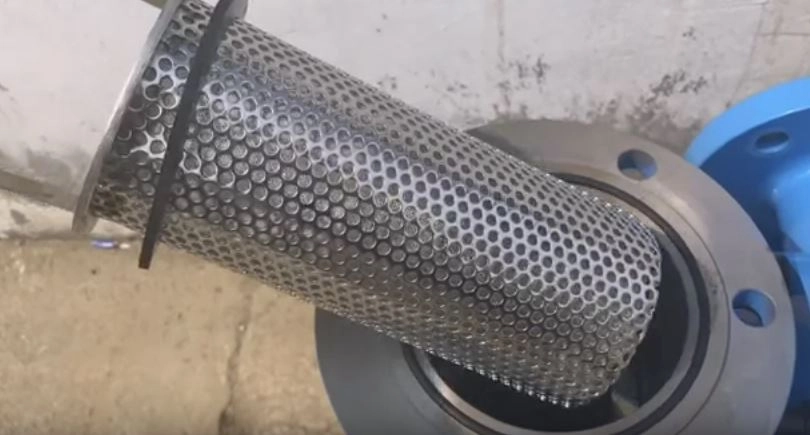
Duplex filter element
- Once the optimal contamination capacity is reached, the alarm alerts for an immediate change-over of the filter element.
- If your duplex filter has no means of indication, then it is recommended to change the filter media twice each year.
- Take precaution before removing the duplex filter element by releasing pressure out of the filter chamber and allow it to cool down.
- The diversion mechanism should enable you to cut-off medium supply and pressure build up in the identified chamber.
- Make sure there are no leakages at the equalizing valve. Proceed to take out the top cover to get access to the filter media.
- As soon as the fluid drains below the filter element before you remove the filter media hold slightly higher to allow it to drip, after a few minutes, take it out.
- Unwrap the new duplex filter element and reinstall it in the same position as the previous one.
- Reassemble the duplex filtering unit and seal the top chamber and make sure the chamber does not leak.
Duplex filter Assembly
Duplex filter assembly is solely designed to offer exquisite filtering of the medium flow under various pressure.
Most hydraulic systems need reliable, clean fluid flow to avoid abrasion wear on downstream components. The redundant duplex filter assembly design makes the filtration operation a success.
The twin chamber assembly allows for change-over of filter media while running. On either side of a chamber, fitted is an electrical circuitry to show a clogged filter unit.
The duplex filter assembly also comprises of a manifold enclosure with a pair of 3 µm rating filter element, lever-handle, a differential pressure gauge and switch, and ball-valve.
The lever-handle is important to create medium flow direction, and show the filter chamber in operation. Note that the correct place of the lever has to be set on either end of the filter chambers.
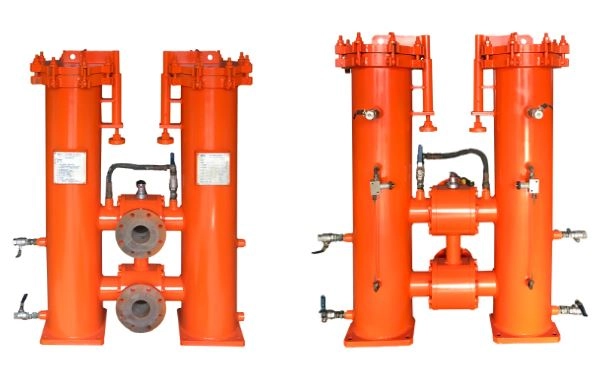
Two opposite sides of duplex filter
As the filtering unit gets contaminated, the pressure differential rapidly increases between the inlet and outlet of the duplex filter assembly. Once the preset limit is reached a switch is turned on to signal on the gauge of imminent clean up schedule.
The operator turns the lever-handle to the other extreme end to bring the stand-by filter chamber on-line. This action is recommended to be swift to avoid system pressure drop.
The presence of twin identical fluid paths and a selector valve controlled by the lever-handle help to carry out medium diversion. The change-over mechanism helps prevent bask flushing into the out of service filtering unit.
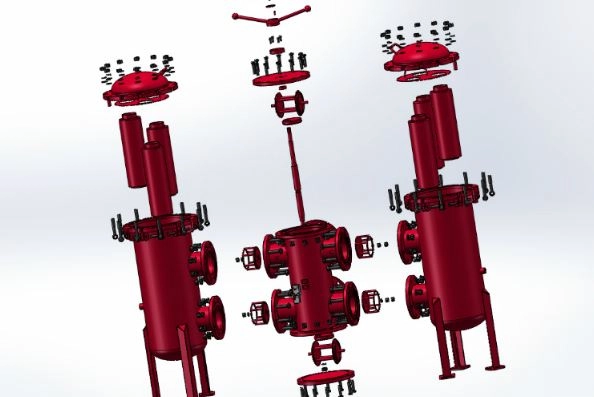
Different parts of duplex filter housing
The change-over procedure can then start or cleaning of the clogged filter unit together with dirty chamber before re-assembling the duplex filter housing.
Cleaning a Duplex Filter Housing
Now, I want to take you through the process of cleaning duplex filter housing. Here’s what you should do:
First of all, check both the pressure and temperature on the duplex filter chamber and confirm whether the medium may be hazardous or corrosive.
Figure 9 Technical drawing of a duplex filter housing
This should give you a safe and secure working environment. Follow the below steps carefully:
- Spot the chamber that requires cleaning and maintenance. With such information in mind, you can start medium flow diversion to the other standby chamber.
- Be cautious as you open the cover top to avoid cracking or forcing out nuts off the bolts. At this point, the chamber should release pressure before getting hold of the duplex filter media.
- Lift out the duplex filter element and use pressurized air to purge out dirt and sediment accumulated inside the duplex filter chamber.
- Use hot compressed water to flush and clean the chamber properly. However, remember to avoid damaging the base chamber from impurities ingress during the thorough cleaning.
- You can as well opt to clean the drain plug and washer. If it is in poor condition, replace it.
- Afterwards, return the cleanable screen into the chamber and make sure it seats squarely into the correct position.
- The handle of the duplex filter element should protrude slightly above the chamber. Restore the ball valve system to its initial position.
- Once the individual units of the duplex filter housing occupy the precise positions, go ahead to cover the chamber and insert the nuts. Before tightening the cover top, inspect to establish whether it seats appropriately before wrapping the exercise.
- Continue to tighten all the bolts and nuts to avoid leakages once the system is running. Once you confirm that the duplex filter housing reinstalled, you can move the lever-handle to allow for partial medium circulation into the cleaned duplex filter housing chamber.
- By doing this, air is vented-off from the chamber and re-seats the screw locks on the duplex filter housing. After a while, you can completely turn the lever-handle for full medium flow into the system.
The exercise should be done for the other chamber of the duplex filter housing when it gets clogged.
Conclusion
As you can see, duplex filter housing come in a range of shapes and designs. However, choosing the right duplex filter housing it the most important.
So far, I have taken you through the most critical aspects you need to consider.
Now, it is your turn, in case you have questions on duplex filter housing – feel free to contact us.
Further Readings
Why Filson Stainless Steel Duplex Filter Housing
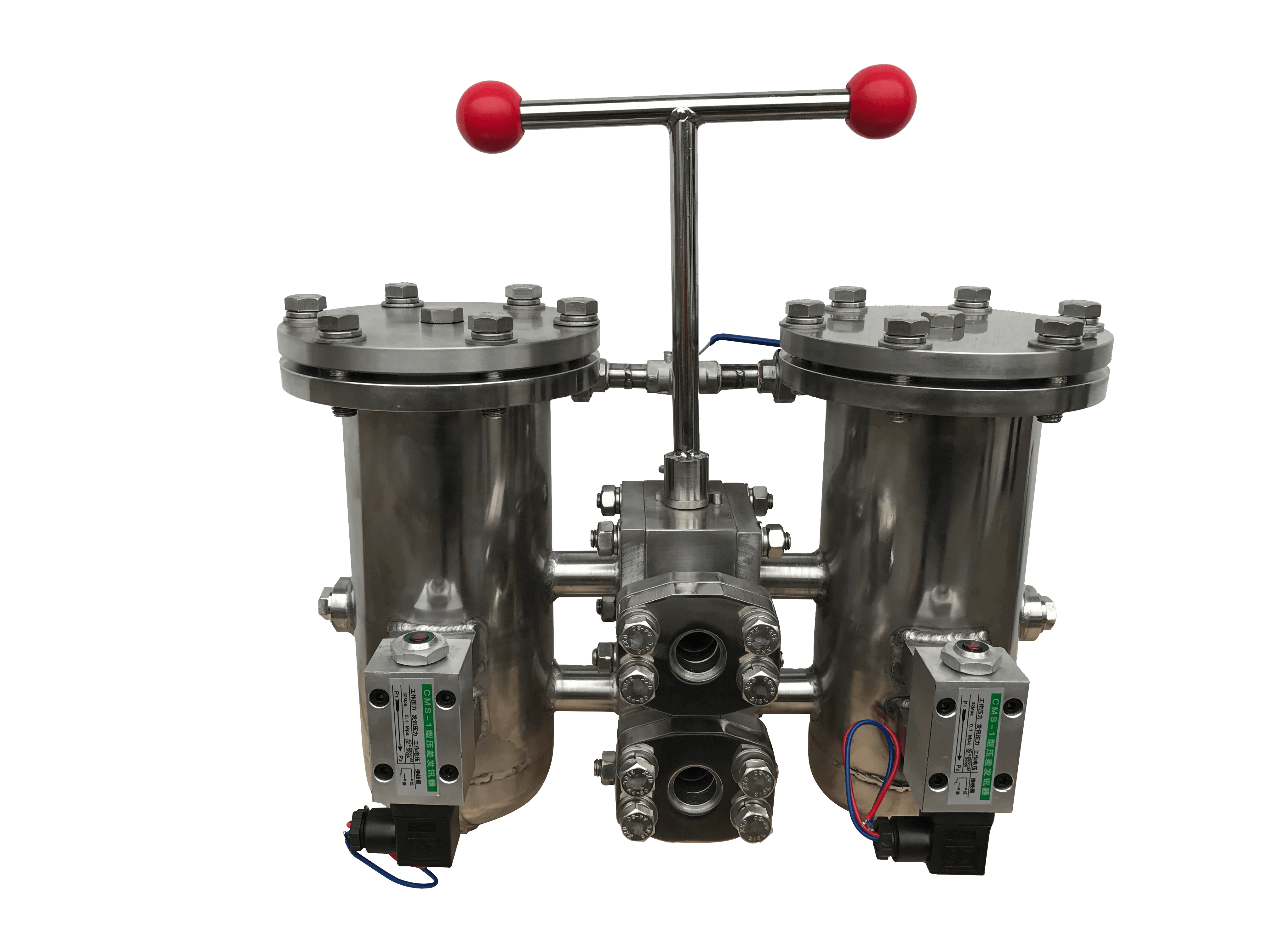
Easy-to-operate lever handle
Flexible, lightweight and quiet operation
304/316 Stainless Steel Filter Housing
Industrial quality, all housings made from SS 316 & SS304 are mirror polished to resist adhesion of dirt and rust.
Clogging Indicator
Indicating when to change filter elements
Vent plug
Efficient air purging to ensure pressure equilibration
Inlet (above) Outlet (below)
Inlet and outlet connections are located on the same or opposite side
Three-way Ball Valve
Longer service life, well sealing. Permit by-passing the filter during elements changes without costly system shutdown
Balance Valve
Used for pressure relief, providing smooth changeover when changing elements.
Clean Side Drain
To remove sediment from filtered oil
Dirt Side Drain
Remove dirt, particles and help to keep the inside working area clean
